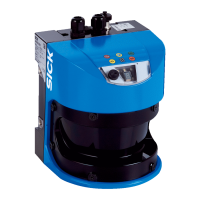Operating Instructions
LMS500 Product Family
Product description
8013796/UL20/2010-09-27 © SICK AG · Division Auto Ident · Germany · Subject to change without notice 25
Chapter 3
Important If you use the “Contour monitoring with blanking” strategy (see section “Evaluation
strategy” on page 31) in the field evaluation application, the contamination measurement
should be configured as inactive. If the contamination measurement is active, erroneous
detections of contour infringements may occur.
3.6 Applications
I
n principle the LMS can be used for two purposes:
• for the measurement of objects (see section 3.7 “Measurement of objects” on
page 25)
• for the detection of objects with evaluation fields (see section 3.8 “Field application” on
page 30)
Therefore, the possible applications are very wide-ranging. In particular the following can be
stated:
• container loading/handling/positioning
• traffic/transport
• robots
• object/building protection (low false alarm rate)
• anti-collision
• navigation
• mapping
3.7 Measurement of objects
3.7.1 Basic parameters
The LMS scans with a scanning frequency of 25 up to 100 Hz or with an angular resolution
of 0.167° up to 1°. At a higher scanning frequency or a finer angular resolution the LMS
supplies more measured values.
PROJECT TREE, LMS…, PARAMETER, BASIC PARAMETERS, areas CURRENT CONFIGURATION and NEW
CONFIGURATION.
Important • The LMS outputs the data after the start of the measurement using the same interface
over which the measured values were requested.
• It is only possible to output all measured values of a scan in real-time using the Ethernet
interface.
In case of an error, the measured value output is stopped immediately and an error code
output that can be evaluated by the application connected. The error code can also be
queried via SOPAS ET from the LMS (see section 8.4 “Detailed error analysis” on page 66).
3.7.2 Filter
The LMS has digital filters for the pre-processing and optimisation of the measured distance
values.

